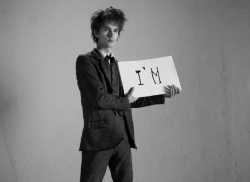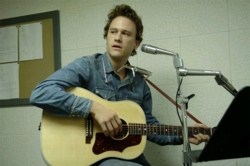Recently I had the great pleasure of giving a lecture at the University of North Carolina at Asheville on Bob Dylan – about Bob Dylan and Man and God and Law to be precise. This reminded me that it's about time to put together work and thinking on Dylan and religion in a book. So over the next few months, that's what I intend to do.
And this work sends me back to some of the writing I have delighted in sharing about Dylan and matters of the spirit over the years. Check out this piece on I'm Not There, Todd Haynes' wonderful reworking of a very Greil Marcusian vision of Dylan (that we dig) and his own delicious view of the music, the man, art, love, quests and all other kinds of good stuff. Elijah and Julie Taymor's "Across the Universe" show up too.
Find the piece in original form here, or in full below.

Like most of Haynes’ film, the first meeting between Bob Dylan and Allen Ginsberg is constructed of a fluid association of anecdotes, lyrics, and wishful thinking, but like any good poetry, it gets closer to the truth than what may or may not have actually happened.
Dylan’s calling towards salvation – what Ginsberg in the golf cart deems both “mission” and “coercion” – is literal, religious, mystical, or otherwise playfully disembodied and transcendent from day-to-day life; and this calling is what flips Dylan’s story forward through a deck of cards of identities including rail riding troubadour (ten year old Marcus Carl Franklin), rebel folkie (Christian Bale), romantic poet (Ben Whishaw), Jude the revolutionary rocker (a masterful Cate Blanchett), megastar family man (Heath Ledger), fundamentalist preacher (Christian Bale, again), and frontier loner (Richard Gere).
“I bargained for salvation an’ they gave me a lethal dose,” Dylan wails in 1974’s “Shelter from the Storm.” And so it goes for artists with creative vision, arrogance, and stamina as deep as his. From Dante to Shakespeare to William Blake, salvation has always been the ultimate destination: the “what now,” the just around the corner, the just within reach, and the never quite real enough to keep.
It has taken Dylan a lot of disguises to stay safe on this trail, and cinematographer Edward Lachman, nominated for an Oscar for his last collaboration with Haynes in 2002’s Far From Heaven, captures long, patient frames and shotgun flashes of Dylan face-to-face with truly lethal doses of salvation, moments when the messiness of life forces the high flyer back to the ground.
Three of these instances stand out: the cocky young singer just arrived in New York, seated sorrowfully before Woody Guthrie dying in hospital bed in 1961; Ledger’s silent despair, sorting family photos after a messy mid-70s divorce; and above all, the tight mask of the ultra hip, self-invented rocker dissolving at the betrayal of a snooty British journalist nemesis who reveals that Jude the legend is in fact a Jewish kid from Brookline, MA named Aaron Jacob Edelstein – the film's version of Robert Zimmerman of Hibbing, Minnesota.
A Tale of Two Wandering Judes
Dylan’s Jude is not the only star by this name rising on cinema screens this season, as the myths of the sixties – and an endless supply of commercials – continue to evolve through the voices of the song books of the masters of the age.
The lead wanderer of Julie Taymor’s story of 60's life and the Beatles, Across the Universe, is named Jude as well; part of the conceit of Across the Universe is to give its characters names out of Beatles songs (Jude's housemates include Prudence, Sadie, and Lucy, and Bono puts in a show-stopping cameo as the hallucinogenic Dr. Robert) so ultimately the entire narrative of the Sixties is told by Beatles songs and enacted by the characters themselves. And just as Dylan/Jude’s marriage unravels with images of the Vietnam War searing television screens in the background in I’m Not There, so too are Taymor’s Jude and his buddies unraveled by bombs in the rice fields of Asia and the streets of New York. It turns out that when it comes to the seemingly eternal music of the golden age of rock and roll royalty (Dylan and the Beatles no doubt sharing the throne above any other pretender to it) beautiful music makes more cultural than historical sense. Yet despite music's naive claims to transcend history, the world is too messy and life too absurd not to leave a scar.
These are the tales of two very different wandering Judes. Despite the thump, holler, and grit of rhythm and blues amidst a catalogue of perfect melodies, the Beatles were really always all about love. It's not hard for Taymor to imagine a happy ending in the musical clues she pieces together, creating a simple love story to soften realities’ growl – even when, as here, that growl includes post-traumatic stress disorder, deportation, and alienation. Jude comes home again regardless of history’s claims upon him, escaping the war, capturing the dream, and eventually getting the girl – because “All You Need Is Love.” But for Dylan/Jude as well as all of the other personae in I’m Not There, the lessons of nearly fifty years of recorded music and thousands of live shows cannot help but end precisely where it all began: facing down mortality and corruption while capturing fleeting beauty in choppy frames of recognition and loss.
Taymor’s film falls flat even as the soundtrack soars because “All You Need Is Love” is simply impossible to believe after what the Sixties as a cultural moment have became – thick with nostalgia and self-congratulation – while Dylan’s story, at least in this version on film, remains raw and troubling despite the pleasure it brings. Both films end on a note of redemptive music – though Gere's Dylan/Billy loses his home and even his dog, he rediscovers the power of old forms of music and hits the road, much like Dylan in the most recent decade and a half of his career. And both end on a note of indeterminacy too. But there is a nostalgic fondness in Taymor's film; it loves to look back. Dylan, like the title of Pennebaker's famous film, always says "Don't look back."
“But I know I Ain't No Prophet”
 All these people that we used to know They're an illusion to me now.
All these people that we used to know They're an illusion to me now.Some are mathematicians
Some are carpenter's wives.
Don't know how it all got started,
I don't know what they're doin' with their lives.
But me, I'm still on the road
Headin' for another joint
We always did feel the same,
We just saw it from a different point of view,
Tangled up in blue.
Stories of Elijah’s countless masks, rages, and demands are embedded throughout Jewish folkways. Elijah, like the early Dylan, wants to speak truth to power – and like that Dylan, he succeeds too well; the people fall for trickery, choose God for the wrong reasons, and eventually Elijah runs away. In exile, Elijah finds the eternal not in the earthquake or the fire, but in a still, small voice, perhaps, we might even say, one which sings. Then, with the command of God at his back, he covers his face, proclaims his zeal for justice, and, despite the many enemies before him, takes to the road, an outlaw ever since.
Elijah is most famous for the moment he does not arrive at all, his wine glass untouched but for the banging on the Passover table as a child wakes with a start to open the door. The prophet makes no sound, raises no hand, and opens no gates to salvation on the holiday when the Exodus from bondage in Egypt is replayed by all who come to celebrate it. “I’m Not There,” he might say as people seek him with eyes tightly shut, not wanting to know what a lethal dose of salvation might really mean.
 The image of the Wandering Jude of Dylan’s oeuvre, unsatisfied with the world as it is and still staying on the road to salvation in spite of it, shares much with another long traveled image of paths of glory, the tireless prophet Elijah.
The image of the Wandering Jude of Dylan’s oeuvre, unsatisfied with the world as it is and still staying on the road to salvation in spite of it, shares much with another long traveled image of paths of glory, the tireless prophet Elijah.
But just as Dylan says, “To live outside the law you must be honest,” in Jewish tradition Elijah can be found everywhere, in disguise, at the gates of a city in the morning and in the houses of royalty by night; he blesses the poor, unsettles the rich, and continually shuffles the deck of fate with his many faces – like the imagined Dylan of I’m Not There– to keep people honest and humble and locked in real time.
Imagine the titles of the three great films on the life and work of Bob Dylan as they might appear in the famous scene of Dylan flashing and dropping cue cards (Allen Ginsberg davening, tongue and cheek, wrapped in a prayer shawl in the background): “Don’t Look Back” – “No Direction Home” – “I’m Not There.” So too goes Haynes’ deep, passionate take on the many lives of Dylan’s seeking: flashes of intimate, gorgeous meaning that stay; and always waiting for just a little bit more.
No comments:
Post a Comment